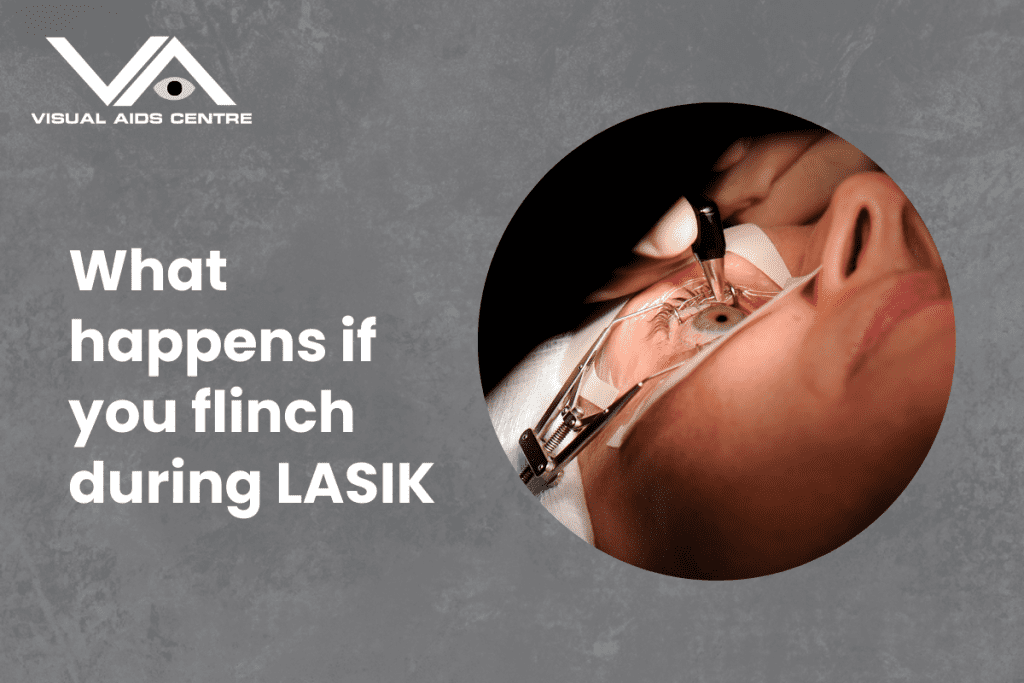Table of Contents
ToggleIf you flinch during LASIK surgery, advanced technology and safety measures ensure that the procedure remains safe and accurate.
The laser automatically pauses, and the surgeon has precise control to address any movement before continuing.
LASIK (Laser-Assisted in Situ Keratomileusis) is a popular vision correction surgery designed to help people achieve clearer vision without relying on glasses or contact lenses. However, it’s natural to have concerns, especially about involuntary actions like blinking or flinching during the procedure. If you’ve been wondering what happens if you flinch during LASIK, rest assured that modern advancements have made the surgery incredibly safe and accommodating. Here’s everything you need to know about how flinching is managed and why you don’t need to worry.

How Does LASIK Work?
Before diving into what happens if you flinch, it’s essential to understand how LASIK works. The surgery is a precise procedure that reshapes your cornea to correct vision issues like nearsightedness, farsightedness, and astigmatism.
Here’s a quick rundown of the process:
- The surgeon uses numbing drops to ensure you don’t feel pain.
- A device holds your eyelid open, so you don’t need to worry about blinking.
- The surgeon creates a thin flap on your cornea, which is folded back to access the underlying tissue.
- A laser reshapes your cornea based on your specific vision prescription.
- The flap is repositioned, and the eye heals naturally without stitches.
While the prospect of having your eye treated can sound intimidating, the entire process usually takes about 10 to 15 minutes per eye and is virtually painless.
Why is Flinching a Common Concern?
The idea of staying perfectly still while a laser works on your eye can understandably make many patients nervous. After all, flinching is a natural reflex, especially if you’re anxious during the procedure. Blinking, moving your eye, or even an unexpected body movement can feel out of your control. However, highly advanced technology is integrated into LASIK to ensure these natural reactions won’t impact the success of your surgery.
What Happens if You Flinch During the Procedure?
1. Advanced Eye Tracking Technology Handles Movements
Modern LASIK devices, such as excimer lasers, come equipped with sophisticated eye-tracking systems. These trackers monitor even the smallest eye movements—in real time—and adjust the laser accordingly. If you move or flinch, the system follows your eye’s position to ensure the laser is directed at the correct spot. This eliminates the risk of misalignment, providing the highest level of precision.
2. The Laser Automatically Pauses
If you make significant movements, such as a sudden flinch or jerk, the laser stops instantly. This safety mechanism ensures that no unnecessary treatment is applied outside the targeted area. Once your eye settles back into the correct position, the surgeon can resume the procedure without compromising accuracy.
3. Your Surgeon is Always in Control
During LASIK, your surgeon has full control over the process. If you flinch, they can stop the procedure, adjust for your movement, and then continue when everything is stable. Rest assured, the surgeon’s expertise and advanced tools ensure the procedure is completed without issues.
4. Supportive Tools Keep Your Eye Stable
To help prevent involuntary movements like blinking or excessive flinching, the surgeon uses a device called a speculum. This tool gently holds your eyelids open, eliminating the risk of blinking during the procedure. Additionally, numbing drops minimise discomfort, reducing your likelihood of flinching.
What If You’re a Particularly Nervous Patient?
For some patients, fear or anxiety might make them especially prone to flinching or other body movements. Here’s how LASIK accounts for that:
- Pre-Operative Preparation:
Before surgery, your doctor will walk you through the steps, calming fears and addressing any concerns. Understanding the procedure helps you feel more relaxed.
- Sedatives:
If nerves are a serious concern, your surgeon may provide a mild sedative to help you stay calm and composed. This ensures you remain at ease throughout the procedure.
- Constant Communication:
During the surgery, the surgeon and their team guide you with clear instructions. You’ll often be asked to focus on a specific light to keep your eyes steady and avoid unnecessary anxiety.
What Are the Chances of Complications?
It’s incredibly rare for flinching to cause issues during LASIK, thanks to the technology and safety protocols in place. However, as with any surgery, there are minimal risks. The likelihood of complications caused by movement is exceptionally low—so low that it should not deter you from considering LASIK. Your surgeon’s skill and the equipment’s precision work together to ensure the best outcomes.
What If You Flinch While the Corneal Flap is Being Created?
The creation of the corneal flap is one of the most critical parts of the LASIK procedure. It’s also a moment when patients might naturally feel nervous. To ensure this step happens safely:
- Modern LASIK uses Femtosecond Lasers:
Unlike traditional microkeratome blades, advanced femtosecond lasers create the corneal flap with extreme precision. These lasers are equipped to stop if any significant movement occurs.
- Surgeon Expertise:
An experienced surgeon carefully monitors your eye position during this step, pausing and adjusting if necessary. Rest assured, they take every precaution to ensure safe and accurate results.
Tips to Stay Calm and Avoid Flinching
Although flinching rarely impacts the outcome of LASIK, staying relaxed can enhance your overall experience. Try these tips to keep calm during your procedure:
- Focus on the light above you as instructed by your surgeon.
- Take deep, slow breaths to steady your nerves.
- Trust in the technology and your surgeon’s expertise—years of training back their every move.
- Use any relaxation techniques that work for you, like meditation or listening to soothing music before the procedure.
Why LASIK Is Designed for Real People?
It’s important to remember that LASIK is performed on thousands of real people every year—flinchy or not! Surgeons and technology manufacturers know that patients are not statues, which is why the procedure is developed to be forgiving of natural reflexes.
The combination of cutting-edge eye-tracking systems, automatic laser pausing, and meticulous surgical oversight makes LASIK one of the safest and most effective procedures in the world. These thoughtful features are specifically designed to handle everyday human movements, putting your mind at ease.
Wrapping Up
Flinching during LASIK is a common concern for first-time patients, but the truth is that it’s rarely an issue thanks to advanced technology and expert care. The safety mechanisms built into modern LASIK ensure your eye movements are anticipated, managed, and accounted for—keeping the entire process safe and effective.
If you’re considering LASIK but have concerns about flinching or other aspects of the procedure, booking a consultation with a qualified surgeon can help answer your questions. With the right information and preparation, you can make an informed decision and embark on your journey to clearer, glasses-free vision.









